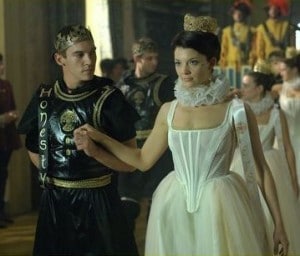 We don’t know exactly what date Anne Boleyn arrived in England after being recalled from France to marry James Butler and we also don’t know when she made her debut at the English court. What we do now, however, is that she was a court on the evening of Shrove Tuesday on the 4th March 1522* playing the part of Perseverance at the pageant of “The Château Vert”.
We don’t know exactly what date Anne Boleyn arrived in England after being recalled from France to marry James Butler and we also don’t know when she made her debut at the English court. What we do now, however, is that she was a court on the evening of Shrove Tuesday on the 4th March 1522* playing the part of Perseverance at the pageant of “The Château Vert”.
Edward Hall, in his Chronicle, describe how on the evening of Shrove Tuesday at York Place, Cardinal Wolsey, the King and ambassadors enjoyed a supper followed by a pageant in the great chamber which was richly decorated with arras and torches. At the end of the chamber was a castle with towers decorated with banners, one showing three “rent hartes” (torn hearts), another showing “a ladies hand gripyng a mans harte” and the third showing “a ladies hand turn-yng a mannes hart” upside down. One of the towers had a cresset burning and in the castle were musicians, hidden from sight, and eight ladies visible in the towers. These ladies, dressed in white satin, were Beauty, Honour, Perseverance, Kindness, Constance, Bounty, Mercy and Pity, the virtues held high in chivalric tradition. The King’s sister, Mary Tudor Queen of France, played Beauty, the Countess of Devonshire played Honour, Jane Parker (later Boleyn) played Constancy, Mary Boleyn played Kindness and Anne Boleyn played Perseverance. Hall describes how each lady had her name (or virtue) embroidered on her dress in gold and how they wore cauls and gold Milan bonnets decorated with jewels.
Hall goes on to describe how these women, or virtues or graces, were guarded by eight women dressed as Indian woman who were named “Dangler, Disdain, Gelousie, Vnkyndenes, Scorne, Malebouche, Straitngenes” or Danger, Disdain, Jealousy Unkindness, Scorn, Malebouche (evil tongue/mouth or Sharp Tongue) and Strangeness, which Eric Ives takes to mean “Off-handedness”. Suddenly eight lords dressed in cloth of gold caps and blue satin cloaks entered the chamber “led by one all in crimosin sattin with burnyng flames of gold, called Ardent Desire”. These men were named “Amorus, Noblenes, Youth, Attendance, Loyaltie, Pleasure, Gentlenes, and Libertie” and ” the kyng was chief of this compaignie”. Ardent Desire then asked the ladies, the virtues, to come down from their towers but Scorn and Disdain told him that “they would holde the place”, so the men attacked the castle throwing dates, oranges “and other fruites made for pleasure” at it. The ladies defended the castle with rose water and “comfittes” or sweetmeats and although Lady Scorn and her company tried to defend themselves with “boows and balles”, they were forced to flee and the lords took the “ladies of honor as prisoners by the handes” and led them out of the castle to dance.
Eric Ives writes:-
“Female coldness having fled before masculine ardour, the warm and soft qualities were taken prisoner.”
Hall then describes how the lords and ladies unmasked themselves and went on to enjoy a “costly banket”, a rich banquet, with those who had watched the Château Vert pageant.
In “The Tudors” series, the Château Vert pageant is where Henry VIII falls in love with Anne Boleyn. He head straights for her tower, their eyes meet and he announces “Perseverance, you are my prisoner now”. He goes on to rescue his sister, but at the dance he can’t seem to keep his eyes off Anne and when they become partners he takes the opportunity to ask her who she is, “I’m Anne Boleyn”, she replies seductively. It is clear that Henry wants her. At the end of the scene, we see Thomas Boleyn handing money to Master Cornish, William Cornish who was the master of the chorister in the Chapel Royal at the time and who, Eric Ives believes, was “the author, designer and producer of the whole affair”. Evidently, we are to assume that Thomas Boleyn asked Cornish to make sure that the King was sent to rescue Anne so that he noticed her. The whole affair seems to have been carefully choreographed by Thomas Boleyn.
Whilst, it is a wonderful scene which really brings the whole Château Vert pageant to life, it is unlikely that Henry noticed Anne at this pageant. Mary Boleyn seems to be missing from this scene in “The Tudors”, but it is thought to be Mary who Henry was besotted with at this time. On the 2nd March 1522, the day after the pageant, Henry VIII rode out at the Shrovetide joust, with its theme of unrequited love, on a horse decorated with a wounded heart and wearing the motto “elle mon coeur a navera”, “she has wounded my heart”. He was not referring to Anne Boleyn but most likely to her sister, Mary Boleyn. Historians believe that he had just fallen in love with Mary and taken her as his mistress.
Notes and Sources
*Eric Ives has the Shrovetide pageant as 1st March and he cites L&P, Calendar of State Papers (Spain) and Hall, but I’ve come to the conclusion that it was on 4th March as Edward Hall’s account of the Shrovetide pageant follows his account for the third day of March and another source has Ash Wednesday as being 5th March.
- Hall’s Chronicle, Edward Hall, p630 – This can be read online at http://www.archive.org/stream/hallschronicleco00halluoft#page/n5/mode/2up. Simply go to page 630 for Hall’s full description of the pageant.
- The Life and Death of Anne Boleyn, Eric Ives, p37-38